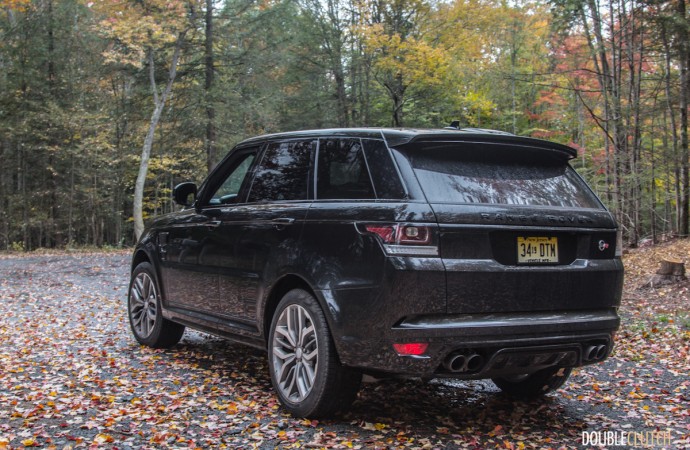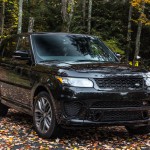The Range Rover name is considered by most to be the world standard in luxury utility vehicles. A British name dating back more than half a century, the Land Rover marque has produced some of the most capable, rugged, and most luxurious vehicles in the world – though often not all of the above criteria applying to the same vehicle. As of late though, speed has become a new area that the Brits want to dominate, and what better utility vehicle to use for this purpose? I took out a 2016 Range Rover Sport SVR, which is said to be one of the most ferocious new sport-utilities available today.
In my eyes, SUVs aren’t exactly sexy – their two-box designs and focus towards utility and flexibility tend to put aesthetics on the back burner. The current generation Range Rover Sport defies this theory; I consider it to be one of the best-looking SUVs ever made. The Sport doesn’t deviate too far from the standard Land Rover/Range Rover formula; it’s unmistakable as a luxurious British ute, but aggressive lines, a hunkered stance and meticulously chosen design cues cause it to stand out against the blander competition. The SVR takes this one step further, with unique wheels, body skirting, a decklid spoiler, and a paint scheme that differentiates it from the ‘regular’ Range Rover models.
But it’s not the design that makes the SVR so special; no. The SVR hails from Jaguar Land Rover’s new “Special Vehicle Operations” department; their equivalent to BMW’s M division or Mercedes-Benz’s AMG. Under the hood of the brute is the familiar 5.0L supercharged V8. In this application, it pushes out 550 horsepower at 6,500RPM and 502 lb-ft of torque at 2,500RPM. The only available transmission is the eight-speed automatic, capable of blipping on downshifts and upshifting 50% quicker than the standard application.
It’s not the sheer straight-line speed that renders the SVR fast, either. It’s the claimed Nürburgring Nordschliefe lap time of just 8 minutes and 14 seconds that renders it the second-fastest SUV in the world. Its 260 km/h top speed is second only to the manic new Porsche Cayenne Turbo S. When you give the SVR full throttle, it puts on a soundtrack from the sports exhaust that’s eerily similar to the brand’s own Jaguar F-Type. Of course, this isn’t exactly a surprise, considering the F-Type R shares its 5.0L motor with the SVR. The roaring noise from the big SUV sounds like a lion in heat – there’s no artificial engine sound piped through the speakers here, either.
Now, the Range Rover Sport SVR weighs a smidge more than the regular Sport, which already comes in at over 5,000lbs. The thing is, once on the road, the SVR feels like it has shed about a thousand pounds. The Continental ContiSportContact tires grip the road like no tomorrow, and it’s quickly forgotten that you’re driving a large, cushy SUV. The steering, while electric, is remarkably good and the SVR tackles corners with the utmost of ease. It’s weighted nicely and actually provides a decent amount of feedback for an electric unit. The torque vectoring setup Range Rover has implemented works well and is noticeable when it sends power to the appropriate rear wheel during cornering. Stopping is done quickly and efficiently via the huge Brembo brakes.
The Sport SVR is the fastest and arguably the best-looking SUV the brand has ever produced, but that doesn’t mean there have been compromises in other departments. The regular Sport’s suspension has been firmed up for the SVR model, with stiffer bushings and more aggressive damping, but it’s still surprisingly comfortable for everyday use. Those who predicted that the SVR would lose the off-road prowess of the Land Rover marque (like this LR4) are proven wrong, as it has a 33-inch wading depth and still maintains transmission settings for venturing off the beaten path – zero compromises here.
The interior of the SVR is surprisingly similar to the standard-issue Sport, with an excellent combination of luxury and minimalism throughout. This model gets unique, heavily-bolstered bucket seats in front, which do a great job holding you in place when tossing the SVR around corners. Other than the seats though, there aren’t many noticeable changes at all. The steering wheel, dashboard upholstery, infotainment system, and everything else is high quality and feels good to the touch. I still find that the infotainment system is dated and is desperately in need of an update, but that’s expected very soon in this model. We’ve already previewed JLR’s latest setup in the new Discovery Sport (see review here).
Land Rover now offers their TD6 clean diesel option on two Range Rover models, both the full-size HSE and the Sport. If fuel economy is a priority, I suggest checking out either of the two. Those who are against the idea of diesel can opt for the 3.0L supercharged V6 motor, which is the entry-level unit in the Range Rover Sport. This SVR is not made for saving fuel, and it doesn’t do anything to convince you otherwise. We averaged 14.1L/100km in combined driving over our test period, and this was making full use of that addictive sport exhaust system. The Sport SVR will accept a whopping 105L of premium fuel.
With some serious heavy hitters in the performance luxury SUV segment like the BMW X5 M (see review), the Porsche Cayenne S, and even the Jeep Grand Cherokee SRT, Land Rover just had to have some of the slice. They may not have been the first in the game, but this entry has not gone unnoticed. Its luxurious interior is second to none, its exuberant exhaust note is almost arousing, and it’s unmistakable as a Range Rover. 2016 Range Rover Sport SVR may be second place in the “fastest SUV in the world”, but it’s an easy winner in a series of other departments.













